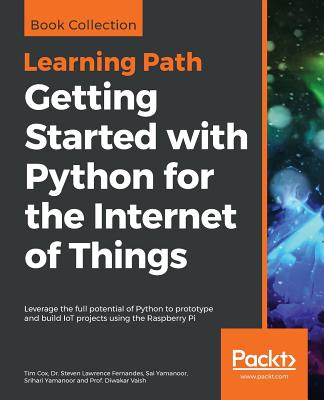Getting Started with Python for the Internet of Things
暫譯: 物聯網的 Python 入門指南
Cox, Tim, Fernandes, Dr Steven Lawrence, Yamanoor, Sai
- 出版商: Packt Publishing
- 出版日期: 2019-02-25
- 售價: $2,080
- 貴賓價: 9.5 折 $1,976
- 語言: 英文
- 頁數: 732
- 裝訂: Quality Paper - also called trade paper
- ISBN: 183855579X
- ISBN-13: 9781838555795
-
相關分類:
Python、程式語言、物聯網 IoT
海外代購書籍(需單獨結帳)
商品描述
Key Features
- Create your own Pi-Rover or Pi-Hexipod robots
- Develop practical applications in Python using Raspberry Pi
- Build your own Jarvis, a highly advanced computerized AI
Book Description
This Learning Path takes you on a journey in the world of robotics and teaches you all that you can achieve with Raspberry Pi and Python.
It teaches you to harness the power of Python with the Raspberry Pi 3 and the Raspberry Pi zero to build superlative automation systems that can transform your business. You will learn to create text classifiers, predict sentiment in words, and develop applications with the Tkinter library. Things will get more interesting when you build a human face detection and recognition system and a home automation system in Python, where different appliances are controlled using the Raspberry Pi. With such diverse robotics projects, you'll grasp the basics of robotics and its functions, and understand the integration of robotics with the IoT environment.
By the end of this Learning Path, you will have covered everything from configuring a robotic controller, to creating a self-driven robotic vehicle using Python.
- Raspberry Pi 3 Cookbook for Python Programmers - Third Edition by Tim Cox, Dr. Steven Lawrence Fernandes
- Python Programming with Raspberry Pi by Sai Yamanoor, Srihari Yamanoor
- Python Robotics Projects by Prof. Diwakar Vaish
What you will learn
- Build text classifiers and predict sentiment in words with the Tkinter library
- Develop human face detection and recognition systems
- Create a neural network module for optical character recognition
- Build a mobile robot using the Raspberry Pi as a controller
- Understand how to interface sensors, actuators, and LED displays work
- Apply machine learning techniques to your models
- Interface your robots with Bluetooth
Who this book is for
This Learning Path is specially designed for Python developers who want to take their skills to the next level by creating robots that can enhance people’s lives. Familiarity with Python and electronics will aid understanding the concepts in this Learning Path.
商品描述(中文翻譯)
**主要特點**
- 創建您自己的 Pi-Rover 或 Pi-Hexipod 機器人
- 使用 Raspberry Pi 開發實用的 Python 應用程式
- 建立您自己的 Jarvis,一個高度先進的計算機 AI
**書籍描述**
這條學習路徑帶您進入機器人技術的世界,教您如何利用 Raspberry Pi 和 Python 實現各種可能性。
它教您如何利用 Raspberry Pi 3 和 Raspberry Pi zero 的強大功能,構建卓越的自動化系統,這些系統可以改變您的業務。您將學會創建文本分類器、預測文字情感,並使用 Tkinter 庫開發應用程式。當您在 Python 中構建人臉檢測和識別系統以及家庭自動化系統時,事情將變得更加有趣,您可以使用 Raspberry Pi 控制不同的家電。通過這些多樣的機器人項目,您將掌握機器人的基本知識及其功能,並理解機器人與物聯網環境的整合。
在這條學習路徑結束時,您將涵蓋從配置機器人控制器到使用 Python 創建自駕機器車的所有內容。
- Tim Cox、Dr. Steven Lawrence Fernandes 的《Raspberry Pi 3 Cookbook for Python Programmers - 第三版》
- Sai Yamanoor、Srihari Yamanoor 的《Python Programming with Raspberry Pi》
- Prof. Diwakar Vaish 的《Python Robotics Projects》
**您將學到什麼**
- 使用 Tkinter 庫構建文本分類器並預測文字情感
- 開發人臉檢測和識別系統
- 創建光學字符識別的神經網絡模組
- 使用 Raspberry Pi 作為控制器構建移動機器人
- 理解如何介面傳感器、執行器和 LED 顯示器的工作原理
- 將機器學習技術應用於您的模型
- 使用 Bluetooth 介面連接您的機器人
**本書適合誰**
這條學習路徑專為希望通過創建能改善人們生活的機器人來提升技能的 Python 開發者而設。熟悉 Python 和電子學將有助於理解這條學習路徑中的概念。
目錄大綱
- Getting Started with a Raspberry Pi 3 Computer
- Dividing Text Data and Building Text Classifiers
- Using Python for Automation and Productivity
- Predicting Sentiments in Words
- Detecting Edges and Contours in Images
- Building Face Detector and Face Recognition Applications
- Using Python to Drive Hardware
- Sensing and Displaying Real-World Data
- Building Neural Network Modules for Optical Character Recognition
- Arithmetic Operations, Loops, and Blinky Lights
- Conditional Statements, Functions, and Lists
- Communication Interfaces
- Data Types and Object-Oriented Programming in Python
- File I/O and Python Utilities
- Requests and Web Frameworks
- Awesome Things You Could Develop Using Python
- Robotics 101
- Using GPIOs as Input
- Making a Gardener Robot
- Basics of Motors
- Bluetooth-Controlled Robotic Car
- Sensor Interface for Obstacle Avoidance
- Making Your Own Area Scanner
- Basic Switching
- Recognizing Humans with Jarvis
- Making Jarvis IoT Enabled
- Giving Voice to Jarvis
- Gesture Recognition
- Machine Learning
- Making a Robotic Arm
目錄大綱(中文翻譯)
- Getting Started with a Raspberry Pi 3 Computer
- Dividing Text Data and Building Text Classifiers
- Using Python for Automation and Productivity
- Predicting Sentiments in Words
- Detecting Edges and Contours in Images
- Building Face Detector and Face Recognition Applications
- Using Python to Drive Hardware
- Sensing and Displaying Real-World Data
- Building Neural Network Modules for Optical Character Recognition
- Arithmetic Operations, Loops, and Blinky Lights
- Conditional Statements, Functions, and Lists
- Communication Interfaces
- Data Types and Object-Oriented Programming in Python
- File I/O and Python Utilities
- Requests and Web Frameworks
- Awesome Things You Could Develop Using Python
- Robotics 101
- Using GPIOs as Input
- Making a Gardener Robot
- Basics of Motors
- Bluetooth-Controlled Robotic Car
- Sensor Interface for Obstacle Avoidance
- Making Your Own Area Scanner
- Basic Switching
- Recognizing Humans with Jarvis
- Making Jarvis IoT Enabled
- Giving Voice to Jarvis
- Gesture Recognition
- Machine Learning
- Making a Robotic Arm




















